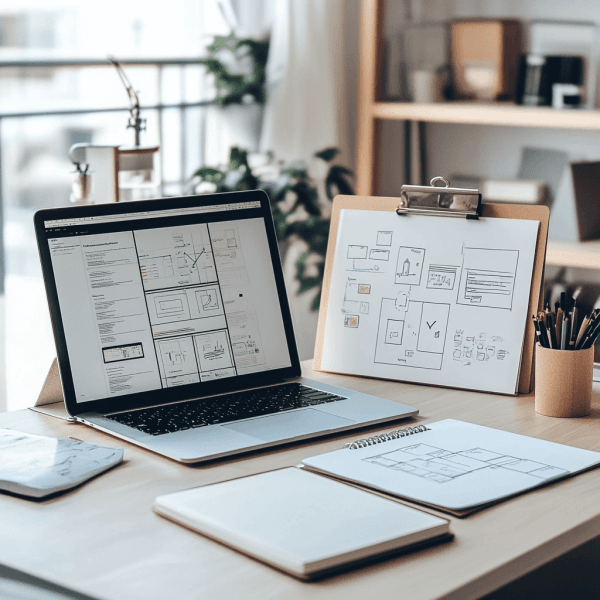So, you’re ready for a new business website – amazing! Creating a new website is an exciting step for any business, brand, or entrepreneur. But before you hire a web designer like us to build a professional, modern, and captivating website, there’s something crucial to do first: prepare your website content.
Well-structured, strategic content ensures your site is designed for user experience (UX), SEO optimization, and your actual business goals. Creating a strategic website isn’t just about how it looks. It’s about what it does for your business.
At our agency, we don’t just build websites – we build digital tools that work.
Here’s what we help you get clear on before we start designing.
Why Content Comes First in Web Design
Many clients assume a website designer or web design agency will “fill in the blanks.” In reality, effective website design must support your content. By “content,” we mean both written words and visuals like photos and logos. While we work with you to find the answers to the following questions in the discovery phase, it helps if you have given some thought to them beforehand.
- What message you want to communicate – What is it that will help connect your potential clients or customers to what you offer?
- What sets you apart – Why are you different and unique?
- What is it that you want potential leads to do – Should they call or book an appointment? Schedule a discovery meeting? Make a purchase?
- What point you are at with imagery, graphics, or logos – Do you have enough? Do they represent you today?
Having content ready (or at least outlined) reduces endless revisions, improves design accuracy, and ensures your final site aligns with your branding, SEO strategy, and marketing goals.
While we offer copywriting services and will help you write and edit your original content to be web-ready, anything you can write down yourself helps us to understand your voice as the creator of your brand or business.
We also help you find or design aligned graphics, as well as set up photography sessions if necessary. But it is good to start out by organizing what you already have.
Below is a step-by-step guide to answering the above questions and preparing content.
Step 1: Define the Goal of Your Website
Every effective website begins with a clear purpose. Before we talk about aesthetics, we’ll clarify purpose. A beautiful website is great. A beautiful website that drives business? Even better. Ask yourself:
• Do I want users to book appointments or consultations?
• Are you selling services or products via an e-commerce? Or both?
• Is your site meant to generate leads with forms or mailing lists?
• Are you planning to build authority and educate with a business blog or resource hub?
This clarity determines everything else: homepage design, navigation structure, and content hierarchy. Your goal shapes everything, from structure to copy to calls to action. Our job is to design around what success means for you.
Step 2: Define Your Target Audience – Who Are You Speaking To?
The best websites don’t just tell your story, they connect with the right people. To do this, you’ll need to have an idea of who is your ideal target audeience.
Everything from tone of voice to layout to navigation should serve your visitor first. That’s how you turn clicks into clients.
Design and content should reflect your ideal customer’s needs. Even a short buyer persona (age, goals, pain points, buying habits) helps your web designer and copywriter create a site that resonates.
Step 3: Focus on Written Content
The best-performing sites are content-led. That means we design around strategy, not just visuals. You don’t need to show up with final copy – we’ve got you. But before we build, you should consider:
• What pages your site needs
• What questions your clients or customers will ask
• What type of content builds trust in your niche
• What supporting content you already have, such as testimonials, reviews, or case studies
Start by writing out what you think your main pages such as the homepage and service or product pages need to say. Don’t worry about perfection, even rough drafts help web designers like us create layouts that fit your message.
Step 4: Gather Visual Assets
Visual storytelling that aligns with your written content is vital for website psychology, readability, and conversion optimization.
Organize or list out what is missing from the following items:
- Logo files
- Professional product photos or team images
- Icons or illustrations
- Video content (explainer videos, testimonials, or product demos)
- Brand colors
- Font Typography (heading and paragraph fonts)
This helps ensure your website branding aligns across all digital marketing platforms.
Step 5: Organize Everything for Your Web Designer
Once you’ve gathered your text, visuals, and brand assets, organize everything into folders and share them with us or your web design team. This helps keep your website project management smooth and efficient.
Remember, visual design is important, but it is just one piece of the puzzle in creating a digital growth tool. Preparing your ideas and written content before hiring a web designer may take effort, but it’s the most important step for creating an effective website that reflects your brand, builds trust, and converts visitors into customers.
By defining your goals, writing content, and organizing visuals, you’ll make the website design process faster, easier, and more successful.
🚀 Let’s Build Smart, Not Just Beautiful
We believe your website should work as hard as you do. So before we start designing, we help you get clear on what matters most: your goals, your audience, and your message.
Ready to build a site that grows your business and your online presence?
Let’s talk.



